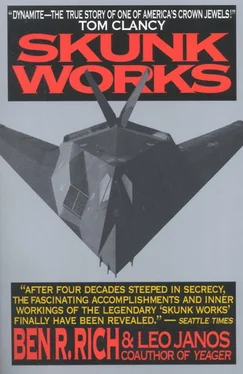In those early days of my tenure at the Skunk Works, Kelly Johnson was still coming in twice a week as my consultant as part of his retirement deal. I had mixed feelings about it. On the one hand, Kelly was my mentor and close friend, but it pained me to see so many colleagues crowding into his small office down the hall from mine, taking their work problems to him instead of to me. Of course, I really could not blame them. No one in our shop came close to possessing Kelly’s across-the-board technical knowledge, but he didn’t just limit himself to providing aerodynamic solutions for stumped engineers; he damned well wanted to know what I was up to, and he wasn’t exactly shy about firing off opinions, solicited or not. After a quarter century of working at his side, I knew Kelly’s views nearly as well as my own, and I also knew that he would not be thrilled about stealth because he thought the days of manned attack airplanes were definitely numbered. “Goddam it, Ben, the future belongs to missiles. Bombers are as obsolete as the damned stagecoach.”
I argued back, “Kelly, the reason they call them missiles, instead of hittles, is that they miss much more than they hit.” But Kelly just shook his head.
Several years earlier, we had built a pilotless drone, the D-21, a forty-four-foot manta ray–shaped ramjet that was launched from B-52 bombers to streak high across Communist China and photograph its nuclear missile test facilities. That drone achieved the lowest radar cross section of anything we had ever built in the Skunk Works, and Kelly suggested that we offer our D-21 to the Air Force as a radar-penetrating attack vehicle, with or without a pilot. I put together a small team to begin a modification design, but I couldn’t stop thinking about stealth.
That first summer of my takeover, our in-house expert on Soviet weapons systems, Warren Gilmour, attended a meeting at Wright Field, in Ohio, and came back in a dark mood. He marched into my office and closed the door. “Ben, we are getting the shaft in spades,” he declared. “One of my friends in the Tactical Air Command spilled the beans. The Defense Department’s Advanced Research Projects Agency has invited Northrop, McDonnell Douglas, and three other companies to compete on building a stealthy airplane. They’re getting a million bucks each to come up with a proof of concept design, trying to achieve the lowest radar signatures across all the frequencies. If one works, the winner builds two demonstration airplanes. This is right up our alley and we are being locked out in the goddam cold.”
This was exactly the kind of project I was looking for. But we had been overlooked by the Pentagon because we hadn’t built a fighter aircraft since the Korean War and our track record as builders of low-radar-observable spy planes and drones was so secret that few in the Air Force or in upper-management positions at the Pentagon knew anything about them.
Warren read my mind. “Face it, Ben, those advanced project guys don’t have a clue about our spy plane work in the fifties and sixties. I mean, Jesus, if you think racing cars, you think Ferrari. If you think low observables, you must think Skunk Works.”
Warren was absolutely right. The trouble was getting permission from our spy plane customer, that legendary sphinx known as the Central Intelligence Agency, to reveal to the Pentagon’s competition officials the low observable results we achieved in the 1960s building the Blackbird, which was actually the world’s first operational stealth aircraft. It was 140,000 pounds and 108 feet long, about the size of a tactical bomber called the B-58 Hustler, but with the incredibly small radar cross section of a single-engine Piper Cub. In other words, that is what a radar operator would think he was tracking. Its peculiar cobra shape was only part of the stealthy characteristics of this amazing airplane that flew faster than Mach 3 and higher than 80,000 feet. No one knew that its wings, tail, and fuselage were loaded with special composite materials, mostly iron ferrites, that absorbed radar energy rather than returning it to the sender. Basically 65 percent of low radar cross section comes from shaping an airplane; 35 percent from radar-absorbent coatings. The SR-71 was about one hundred times stealthier than the Navy’s F-14 Tomcat fighter, built ten years later. But if I knew the CIA, they wouldn’t admit that the Blackbird even existed.
Kelly Johnson was regarded almost as a deity at the CIA, and I had him carry our request for disclosure to the director’s office. To my amazement, the agency cooperated immediately by supplying all our previously highly classified radar-cross-section test results, which I sent on to Dr. George Heilmeier, the head of DARPA (the Defense Department’s Advanced Research Projects Agency), together with a formal request to enter the stealth competition. But Dr. Heilmeier called me, expressing regrets. “Ben, I only wish I had known about this sooner. You’re way too late. We’ve given out all the money to the five competitors.” The only possibility, he thought, would be to allow us to enter if we would agree to a one dollar pro forma government contract. As it turned out, if I had done nothing more that first year than refuse that one dollar offer, I had more than earned my salary. I was sitting on a major technological breakthrough, and if I took that government buck, the Feds would own the rights to all our equations, shapes, composites—the works. Lockheed was taking the risks, we deserved the future profits.
It took a lot of arguing at my end, but Dr. Heilmeier finally agreed to let us into the stealth competition with no strings attached, and it was the only time I actually felt good about not receiving a government contract. But not Kelly. “You’re wasting your time,” he told me. “This is like chasing a butterfly in a rain forest because in the end the government won’t invest big dollars in stealth, when for the same money they can invest in new missiles.”
In part, I think, Kelly was trying to be protective. He didn’t want me to risk an embarrassing failure my first turn at bat, pursuing a high-risk project with little apparent long-range potential. I would be spending close to a million dollars of our own development money on this project, and if Kelly was right, I’d wind up with nothing to show for it. Still, I never waivered from believing that stealth could create the biggest Skunk Works bonanza ever. It was a risk well worth taking, proving a technology that could dominate military aviation in the 1980s even more than the U-2 spy plane had impacted the 1950s. At that point the Russians had no satellites or long-range airplanes that could match our missions and overfly us. Stealth would land the Russians on their ear. They had no technology in development that could cope with it. So I resolved to see this project through, even if it meant an early fall from grace. My department heads would go along because they loved high-stakes challenges, with most of the risks falling on the boss. I confided my stealth ambitions to Lockheed’s new president, Larry Kitchen, who was himself dancing barefoot on live coals while trying to pull our corporation up to a standing position after the pulverizing year and a half of scandals and bankruptcy. Larry cautioned me: “We need real projects, not pipedreams, Ben. If you’ve got to take risks, at least make sure you keep it cheap, so I can back you without getting my own head handed to me. And if something goes sour, I want to be the first to know. My blessings.” Good man, Larry Kitchen. After all, he had also approved hiring me as Kelly’s successor.
Denys Overholser reported back to me on May 5, 1975, on his attempts to design the stealthiest shape for the competition. He was wearing a confident smile as he sat down on the couch in my office with a preliminary designer named Dick Scherrer, who had helped him sketch out the ultimate stealth shape that would result in the lowest radar observability from every angle. What emerged was a diamond beveled in four directions, creating in essence four triangles. Viewed from above the design closely resembled an Indian arrowhead.
Читать дальше












